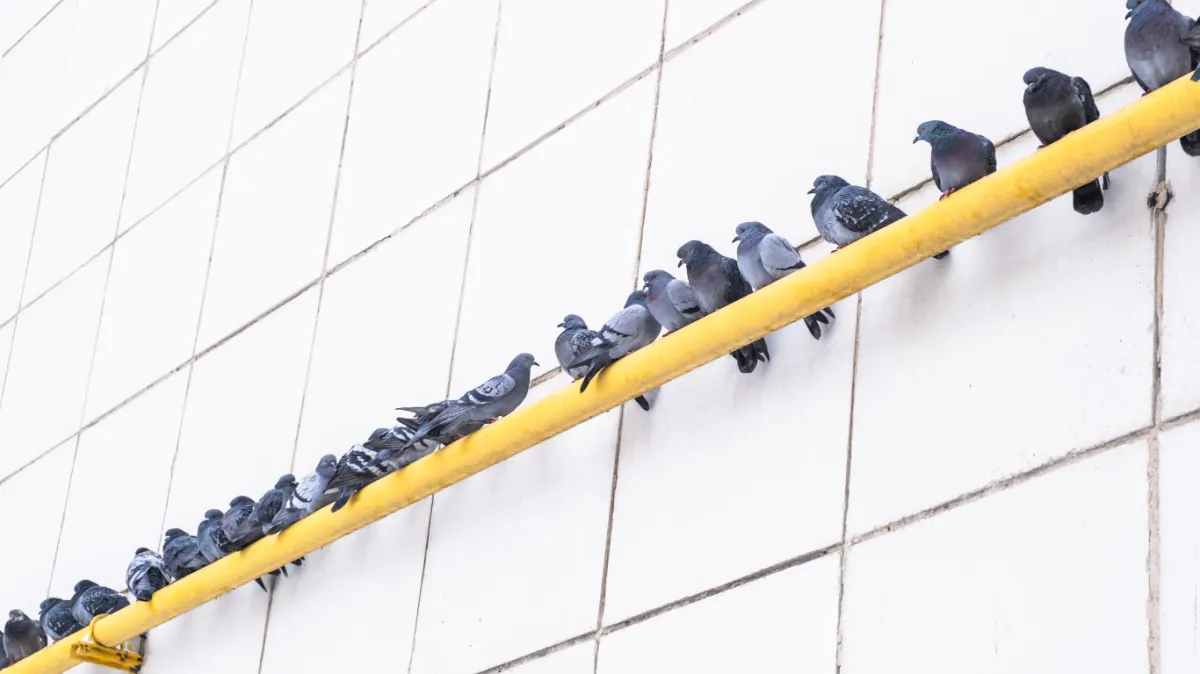
Bird-Proofing Your Commercial Property: Your Summer Readiness Checklist
Inspect for Signs of Bird Activity
Before choosing the right bird control solutions, the first and most crucial step is to evaluate the severity and nature of the problem. Birds are creatures of habit—once they identify a commercial property as a reliable source of food, shelter, or safety, they will return frequently and often bring more with them.Conducting a thorough inspection helps you understand where birds are nesting, roosting, and feeding, so you can develop a strategic plan for prevention and exclusion.
Here’s a checklist of key signs to look for during your summer inspection:
1. Accumulated Droppings (Guano)
Look for bird feces on window sills, ledges, balconies, and rooftops.
Droppings tend to accumulate quickly and can be extremely acidic—corroding building materials, signage, and HVAC equipment.
Fecal matter also poses health risks due to pathogens like histoplasmosis and salmonella.
2. Nesting Materials
Birds like pigeons and sparrows use twigs, leaves, feathers, and trash to build nests in hidden or sheltered spaces.
Check gutters, corners of roofs, open eaves, electrical signage, and behind HVAC units.
Nests can block drainage systems and create fire hazards if near wiring or exhaust systems.
3. Repetitive Bird Presence or Congregation
Observe areas where birds frequently land, feed, or gather, especially during early morning and late afternoon hours.
Watch for pigeons on rooftop edges, sparrows near open vents, or seagulls circling food disposal zones.
Regular congregation often signals a local food source or safe roosting zone.
4. Damage to Rooftop Equipment or Building Infrastructure
Birds peck at insulation, wiring, and rooftop membranes, leading to water leaks, system failures, or structural compromise.
HVAC units are a common target for nesting or pecking activity.
Droppings can clog drainage vents or cause malfunctions in rooftop systems.
5. Noise Complaints from Staff or Tenants
Large flocks—especially starlings or seagulls—create persistent noise that can disrupt daily operations or tenant satisfaction.
Birds in air ducts or attics may also cause scratching or chirping sounds, especially early in the morning or near sunset.
Commercial tenants may also report sightings of birds flying indoors, especially if doors or loading docks are frequently open.
Clean Up Droppings and Nesting Materials Safely
Cleaning up bird mess isn’t just a matter of appearance—it’s a critical safety and maintenance task. Bird droppings and nesting debris are highly acidic, corrosive, and often carry pathogens that pose a threat to both property and health. If left untreated, these materials can damage building surfaces, equipment, and create slipping hazards in high-traffic areas.Moreover, improper handling can stir up airborne contaminants, increasing the risk of respiratory issues for staff or customers.To ensure your cleanup efforts are both effective and safe, follow these recommended practices:
1. Use Personal Protective Equipment (PPE)
Before beginning any cleanup, make sure you're properly protected to avoid direct contact with contaminated materials.
Always wear:
Disposable gloves (nitrile or rubber) to avoid contact with bacteria and parasites
A face mask or respirator (N95 or better) to prevent inhaling dust, spores, or dried droppings
Protective eyewear or safety goggles to shield eyes from splashes or debris
2. Moisten and Sanitize Droppings Before Removal
Instead:
Lightly mist the affected area with water or a commercial disinfectant approved for avian waste
Let it soak for several minutes to minimize airborne particles
Gently remove with a disposable cloth or scoop
3. Properly Bag and Dispose of Nesting Materials
Nests often contain a mix of feathers, feces, and foreign debris that can harbor mites, bacteria, and parasites.
Disposal tips:
Use heavy-duty garbage bags or contractor-grade liners
Double-bag materials for added containment
Seal tightly before placing in outdoor trash or approved waste containers
Wash hands thoroughly after handling, even if gloves were worn
4. Sanitize the Area After Cleanup
Once the debris is removed, it’s essential to disinfect the area to eliminate any remaining pathogens.
Use EPA-approved disinfectants safe for commercial surfaces
Pay attention to touchpoints like railing tops, window sills, door handles, and utility enclosures
Let the solution sit for the recommended dwell time to ensure efficacy
Install Physical Bird Deterrents on Vulnerable Areas
Once your property has been cleared of droppings, nests, and debris, the next step is to make sure birds don’t return. The most effective way to do this is by installing physical bird deterrents—proven, humane tools that make your commercial space inhospitable for roosting, nesting, and perching.At Axon Extermination, we provide customized bird-proofing systems designed for commercial buildings, warehouses, restaurants, retail outlets, and healthcare facilities. All of our solutions are eco-friendly, discreet, and compliant with local wildlife protection laws.Here’s a breakdown of the most effective deterrents we offer:
1. Bird Spikes
Designed to prevent birds from perching on flat surfaces like ledges, railings, signs, and window sills.
The blunt, angled rods create an uncomfortable landing surface without causing harm.
Ideal for deterring pigeons, seagulls, and sparrows in high-traffic areas like storefronts and awnings.
2. Bird Netting
Creates a complete physical barrier that blocks birds from accessing sensitive or open-air structures.
Commonly installed in:
Warehouse rafters
Loading docks
Roof overhangs
Building alcoves
Netting is discreet, UV-stabilized, and highly durable, offering long-term protection against nesting.
3. Visual Deterrents
Birds are easily startled by movement, reflection, and perceived predators.
These deterrents include:
Reflective tape or foil streamers
3D predator decoys like owls or hawks
Shiny discs or rotating devices that catch sunlight
While visual deterrents are not a standalone solution, they work well when used in combination with physical barriers.
Whether you manage a restaurant, retail space, warehouse, or healthcare facility, bird-proofing your property is critical for safety, compliance, and peace of mind.
With over 35 years of experience and industry-leading, non-toxic methods, Axon Extermination delivers custom bird control strategies that work.
[https://axonextermination.com/]